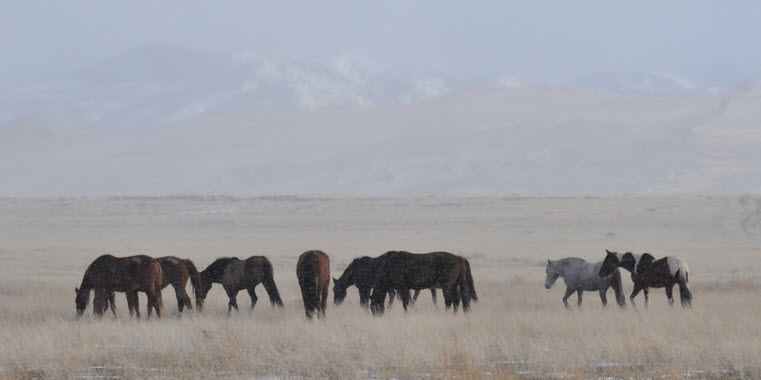The Bureau of Land Management (BLM) and the University of Wyoming are beginning a study to learn more about wild horse seasonal use and movements in the Adobe Town herd management area (HMA).
The study will begin with a
UW scientists Derek Scasta and Jeff Beck, both in the Department of Ecosystem Science and Management, are heading the research. Jake Hennig, a Ph.D. student in the department, also will participate. They will use the information gleaned from the radio collars to learn more about how wild horses interact with their environment. Specifically, the researchers will study migration patterns and herd movements in the HMA. The BLM says it will use the study results to ensure wild horse herds continue to thrive on healthy rangelands.
The Wyoming Department of Agriculture has provided $120,000 to start the research. The BLM also has contributed funding.
Bait-trapping involves setting up temporary corrals within the HMA to attract wild horses safely into the corral. When a certain number of horses has entered the pen, the gate to the corral is closed. Once the horses are gathered, trained personnel will load and transport selected mares to the Rock Springs Wild Horse Holding Facility. After the horses arrive at the facility, staff from the U.S. Geological Survey will place collars with GPS tracking devices on the horses. The horses will then be returned to the HMA.
The 20-30 mares that BLM will select to wear GPS collars will be 5 years old or older. All other wild horses gathered will be immediately released shortly after the selected mares are sorted and held for collaring. All mares will be released at or near the same location where they were gathered. The selected contractors are in the process of identifying trap site locations and will begin the bait-trapping process soon.
Corrals could be set up in stages over a period of days to allow the horses to grow accustomed to the enclosures. About three to five trap sites are required to distribute radio-collared
The number of people in the trap area will be limited to key personnel to ensure a successful and safe gather for the horses.
Public viewing opportunities will be limited. Public viewing is always allowed at the wild horse holding facility overlook in Rock Springs, where the mares will be taken to be collared. Public viewing also will be allowed at the release sites of the collared mares. The BLM will keep a list of people who would like to attend the releasing of the collared mares and notify them at least one day before the releases. Media and interested public can view and photograph the mares being released with the GPS collars. To add your name to the list for public viewing, contact BLM Public Affairs Officer Tony Brown at (307) 352-0215.
The BLM’s Rawlins Field Office released the decision record and finding of no significant impact for the Adobe Town HMA Wild Horse Movements and Habitat Selection Research Gather Environmental Assessment Nov. 9, 2016. The decision was to allow enough wild horses to be gathered by bait trapping, so up to 30 selected mares could be outfitted with GPS collars. The BLM will use two separate contractors to conduct the bait-trapping operations.
Source: University of Wyoming News Release



